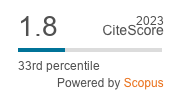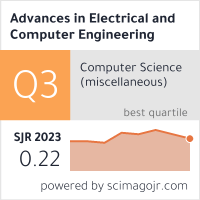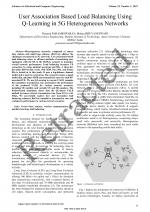| 1/2025 - 6 |
RETRACTED ARTICLE: User Association Based Load Balancing Using Q-Learning in 5G Heterogeneous NetworksPARAMESWARAN, R. |
| Extra paper information in |
| Click to see author's profile in |
| Download PDF |
Author keywords
base stations, wireless communication, 5G, machine learning, load balancing
References keywords
networks(12), communications(10), load(7), heterogeneous(7), balancing(7), technology(6), systems(6), network(6), learning(5), communication(5)
Blue keywords are present in both the references section and the paper title.
About this article
Date of Publication: 2025-02-28 | This article was retracted by the authors on 2025-03-07
Volume 25, Issue 1, Year 2025, On page(s): 53 - 60
ISSN: 1582-7445, e-ISSN: 1844-7600
Digital Object Identifier: 10.4316/AECE.2025.01006
SCOPUS ID: 105001517575
Abstract
Heterogeneous networks, composed of macro base stations and small base stations, effectively address the challenges encountered in 5G networks. User association-based load balancing refers to efficient methods of associating user equipment with the BS in the HetNets scenario to maximize overall network performance. Load balancing increases UE connection by using minimal spectrum and BSs. A three-tier downlink HetNet that works with MBS, Pico BSs, and Femto BSs is looked at in this study. It uses a log-distance channel model and is used in rural areas. The research creates a signal model that calculates SINR and transmission rates for each BS-associated UE. We use Q-Learning to execute UALB, compute the cumulative transmission rate, and analyze the performance of the produced UALB for various network scenarios, including UE mobility and variable UE and BS numbers. The Python-based simulation shows that the QL-based UALB method increases network transmission rate from 0.91 to 4.44 Mbps. We successfully explore how user association load balancing enhances HetNets cumulative transmission rate and evaluate its performance in various network scenarios. |
| References | | | Cited By «-- Click to see who has cited this paper |
| [1] A. Gohil, H. Modi and S. K. Patel, "5G technology of mobile communication: A survey," in 2013 international conference on intelligent systems and signal processing (ISSP). IEEE, 2013, pp. 288-292.
[3] P. Ramesh et al., "Software defined network architecture based network slicing in fifth generation networks," Inf. Midem-J. Microelectron. Electron. Compon. Mater., Vol. 54, No. 2(2024), pp. 123-130. [4] J. Isabona, C. C. Ugochukwu, A. L. Imoize and N. Faruk, "An empirical comparative analysis of 4G LTE network and 5G new radio," in 2022 5th Information Technology for Education and Development. IEEE, 2022, pp. 1-5. [5] C.-X. Wang, F. Haider, X. Gao, X.-H. You, Y. Yang, D. Yuan, H. M. Aggoune, H. Haas, S. Fletcher and E. Hepsaydir, "Cellular architecture and key technologies for 5G wireless communication networks," IEEE communications magazine, vol. 52, no. 2, pp. 122-130, 2014. [6] S. M. Abd El-atty and Z. Gharsseldien, "On performance of hetnet with coexisting small cell technology," in 6th Joint IFIP Wireless and Mobile Networking Conference (WMNC). IEEE, 2013, pp. 1-8. [7] B. Rong, X. Qiu, M. Kadoch, S. Sun and W. Li, 5G heterogeneous networks: Self-organizing and optimization. Springer, 2016 [8] A. Sharma, A. Roy, S. Ghosal, R. Chaki and U. Bhattacharya, "Load balancing in cellular network: A review," in 2012 Third International Conference on Computing, Communication and Networking Technologies (ICCCNT'12). IEEE, 2012, pp. 1-5. [9] T. M. Shami, D. Grace, A. Burr and J. S. Vardakas, "Load balancing and control with interference mitigation in 5G heterogeneous networks," EURASIP Journal on Wireless Communications and Networking, vol. 2019, pp. 1-12, 2019. [10] A. G. Barto, "Reinforcement learning," in Neural systems for control. Elsevier, 1997, pp. 7-30 [11] M. A. Wiering and M. Van Otterlo, "Reinforcement learning," Adaptation, learning, and optimization, vol. 12, no. 3, p. 729, 2012 [12] A. Damnjanovic, J. Montojo, Y. Wei, T. Ji, T. Luo, M. Vajapeyam, T. Yoo, O. Song and D. Malladi, "A survey on 3GPP heterogeneous networks," IEEE Wireless Communications, vol. 18, no. 3, pp. 10-21, 2011. [13] A. Aijaz, H. Aghvami and M. Amani, "A survey on mobile data offloading: Technical and business perspectives," IEEE Wireless Communications, vol. 20, no. 2, pp. 104- 112, 2013. [14] S. Yanzhi, L. Yuming, W. Quan, F. Cheng and J. Liqiong, "Multi-factor load balancing algorithm for 5G power network data center," in 3rd International Conference on Advances in Computer Technology, Information Science and Communication (CTISC), 2021, pp. 188-193. [15] Y. Lin and W. Yu, "Joint spectrum partition and user association in multi-tier heterogeneous networks," in 2014 48th Annual Conference on Information Sciences and Systems (CISS), 2014, pp. 1-6. [16] H. Zhang, L. Song and Y. J. Zhang, "Load balancing for 5G ultra-dense networks using device-to-device communications," IEEE Transactions on Wireless Communications, vol. 17, no. 6, pp. 4039-4050, 2018. [17] M. K. Hasan, T. C. Chuah, A. A. El-Saleh, M. Shafiq, S. A. Shaikh, S. Islam and M. Krichen, "Constriction factor particle swarm optimization-based load balancing and cell association for 5G heterogeneous networks," Computer Communications, vol. 180, pp. 328-337, 2021. [18] M. S. Ali, P. Coucheney and M. Coupechoux, "Load balancing in heterogeneous networks based on distributed learning in near-potential games," IEEE Transactions on Wireless Communications, vol. 15, no. 7, pp. 5046-5059, 2016. [19] T. Zhou, Z. Liu, J. Zhao, C. Li and L. Yang, "Joint user association and power control for load balancing in downlink heterogeneous cellular networks," IEEE Transactions on Vehicular Technology, vol. 67, no. 3, pp. 2582-2593, 2018. [20] 3GPP, "Study on channel model for frequencies from 0.5 to 100 GHz," Tech. Rep. TR 38.901 V14.3.0 R14, 2017 [21] B. Jabbari, Y. Zhou and F. Hillier, "Random walk modelling of mobility in wireless networks," in VTC'98. 48th IEEE Vehicular Technology Conference. Pathway to Global Wireless Revolution (Cat. No. 98CH36151), vol. 1. IEEE, 1998, pp. 639-643. [22] R. Sutton and A. Barto, Reinforcement learning, second edition: An introduction. MIT Press, 2018 [23] R. Parameswaran, S. Shree, S. Sneha, A. Lara Levincy, P. T. V. Bhuvaneswari and S. Ezhilarasi, "Silhouette analysis based K-Means clustering in 5G heterogenous network," 2023 International Conference on Intelligent Technologies for Sustainable Electric and Communications Systems (iTech SECOM), Coimbatore, India, 2023, pp. 541-545. [24] A. M. B. Deepak Athipan, M. Subha Dharshini, R. Parameswaran and R. Shanmugapriya, "Investigation on the impact of CQI index in performance enhancement of 5G downlink systems," 2024 10th International Conference on Advanced Computing and Communication Systems (ICACCS), Coimbatore, India, 2024, pp. 162-166. [25] W. Dghais, M. Souilem, H. R. Chi, A. Radwan and A. -E. M. Taha, "Dynamic clustering for power effective small cell deployment in HetNet 5G networks," ICC 2020 - 2020 IEEE International Conference on Communications (ICC), pp. 1-5, 2020. Web of Science® Citations for all references: 0 SCOPUS® Citations for all references: 0 Web of Science® Average Citations per reference: 0 SCOPUS® Average Citations per reference: 0 TCR = Total Citations for References / ACR = Average Citations per Reference We introduced in 2010 - for the first time in scientific publishing, the term "References Weight", as a quantitative indication of the quality ... Read more Citations for references updated on 2025-05-29 02:17 in 3 seconds. Note1: Web of Science® is a registered trademark of Clarivate Analytics. Note2: SCOPUS® is a registered trademark of Elsevier B.V. Disclaimer: All queries to the respective databases were made by using the DOI record of every reference (where available). Due to technical problems beyond our control, the information is not always accurate. Please use the CrossRef link to visit the respective publisher site. |
Faculty of Electrical Engineering and Computer Science
Stefan cel Mare University of Suceava, Romania
All rights reserved: Advances in Electrical and Computer Engineering is a registered trademark of the Stefan cel Mare University of Suceava. No part of this publication may be reproduced, stored in a retrieval system, photocopied, recorded or archived, without the written permission from the Editor. When authors submit their papers for publication, they agree that the copyright for their article be transferred to the Faculty of Electrical Engineering and Computer Science, Stefan cel Mare University of Suceava, Romania, if and only if the articles are accepted for publication. The copyright covers the exclusive rights to reproduce and distribute the article, including reprints and translations.
Permission for other use: The copyright owner's consent does not extend to copying for general distribution, for promotion, for creating new works, or for resale. Specific written permission must be obtained from the Editor for such copying. Direct linking to files hosted on this website is strictly prohibited.
Disclaimer: Whilst every effort is made by the publishers and editorial board to see that no inaccurate or misleading data, opinions or statements appear in this journal, they wish to make it clear that all information and opinions formulated in the articles, as well as linguistic accuracy, are the sole responsibility of the author.



